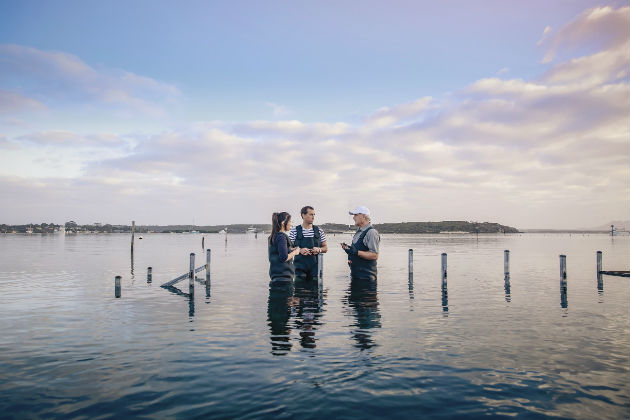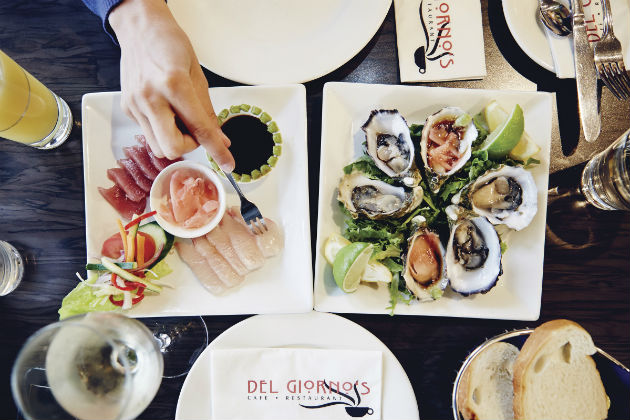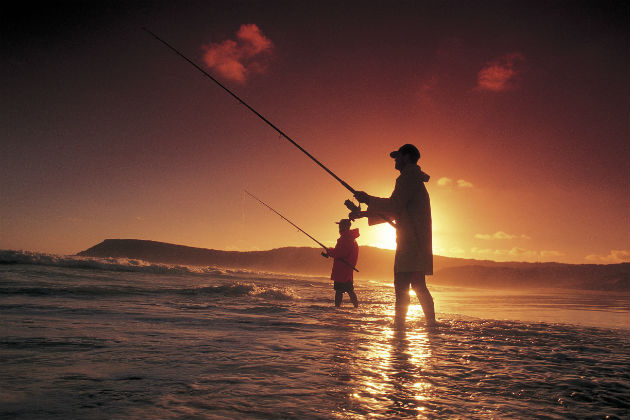29 November, 2017 By: Sue Gough Henly
I'm slurping plump, just-shucked opalescent oysters while sitting in waders beside a white-clothed table that is placed in the water.
It’s only then that I learn that oysters are hermaphrodites.
“Mother Nature basically says, ‘okay guys, half of you have to flip it for nature,’” says South Australia Coffin Bay oyster farmer Ben Catterall, owner of Oyster Farm Tours.
His colourful turns of phrase give us landlubbers a graphic sense of how oysters grow and also how Aussies have devised ingenious ways to help them grow better.

The saying goes that when the world is your oyster, Coffin Bay is the pearl. This nutrient-rich estuary has all the right conditions to create some of Australia’s finest oysters, which are served in our top restaurants.
Nothing, however, beats savouring them at their source and learning how to shuck them in situ.
Until I visited this starkly beautiful region, I had no idea about the diversity of seafood that comes from the waters around the Eyre Peninsula. I learnt that the cold, high-nutrient waters of the Great Australian Bight are perfect for Southern Bluefin tuna, snapper, Southern rock lobsters and abalone.
Spencer Gulf’s warm saline waters are ideal for prawns, calamari and blue swimmer crabs, while the swirling estuaries are superb for oysters, garfish and King George whiting. And there’s Port Lincoln itself, the seafood capital of Australia, where tuna are ranched and kingfish and mussels farmed in Boston Bay, one of the world’s largest harbours.
After flying into Port Lincoln or Ceduna, visitors can enjoy a classic 400km road trip between the two towns. Alternatively, some choose to tackle the Nullarbor from Western Australia.
This is a landscape of blond grain paddocks with the occasional mobs of kangaroos and emus. Along the coast are striking ochre limestone cliffs and wild scrub-dotted dunes framing one exquisite, deserted white-sand beach after another.
Here you’re surrounded by translucent aquamarine waters full of goodies, but how do you get your hands on them?
There are terrific oysters and other seafood at Coffin Bay’s 1802 Oyster Bar and Bistro and you can buy a wide range of fish and shellfish at Port Lincoln’s Fresh Fish Place and Streaky Bay Seafood. There’s also enterprising locals who’ll take you to gather and guzzle sublime seafood at the source. The side order of spectacular scenery comes at no extra cost.

An ocean-to-plate seafood cruise
Rod and Simone Keogh of Eyre Peninsula Cruises offer memorable ocean-to-plate seafood culinary adventures in Streaky Bay.
“Our goal is to help guests experience what we are lucky enough to enjoy in our daily lives with our family and friends,” says Rod as we head out on their state-of-the-art cruiser.
Their good mate and professional chef Brock Trezona whets our appetites with oyster shooters made with vodka, Tabasco and Worcestershire sauce, complete with celery stick.
Rod points out a huge leatherback turtle on our way to the crab pots.
“Pull them in hard and fast or the crabs will escape,” calls Simone, and I’m rewarded with three big bright blue swimmer crabs.
Once we’re anchored near a deserted sandy beach, Simone offers me a flute of local Lincoln Estate sparkling wine, which I juggle with the fishing rod that Rod has put in my hands. Within minutes I’m hauling in silvery Tommy Ruff, “the sweetest fish in the sea”, and Brock serves it both as sashimi and in a ceviche, cured with limes, onion and peppers.
“I like to offer each seafood delicacy straight out of the water and then use different spices and cooking techniques so you can compare the flavours,” says Brock.
Rod and I jump in the warm clear water to snorkel above sea-grass beds in search of razor fish.
Later, while we try stand-up paddle boarding, Brock works his magic in the kitchen and soon we’re savouring sashimi razor fish, sublime chili crab and garfish prepared with olives, baby tomatoes and lemon rind.
Hunt and gather seafood safari
Former farmer David Doudle, who everybody calls Lunch, came up with his idea of Goin’ Off Safaris while sitting on a tractor.
“I decided it’d be fun to show people where I learned to swim, dive, surf and spearfish.”

For a farm boy, this guy sure knows a lot about the sea. Picking us up in his four-wheel drive, Lunch heads directly onto the fine white sand of Long Beach on the edge of Coffin Bay National Park.
Soon we’ve collected two buckets of mud cockles, renowned in places such as Venice as vongole.
“In Australia, people used these as bait but, now they’re quite the delicacy,” laughs Lunch.
As we drive north of Coffin Bay to his secret spots, Lunch tells me, “Anyone can access sealed roads. It’s when you go off-grid with a local that you have unique, authentic experiences.”
The rest of the day we do just that. We scrabble down a goat track to a hidden cove and Lunch dons a snorkel and mask in search of abalone.
Minutes later he’s back with five black and green-lipped sea snails, which he slices out of their iridescent shells and pounds with a rock to tenderise.
We lurch the four-wheel drive over sand dunes behind the wide, creamy sweep of Drummond Beach to go surf casting for hard-fighting Australian salmon in waters that tantalise from turquoise and aqua to cobalt blue.
Eventually we set up table and chairs and Lunch cooks up a feast on his custom-made trailer: sautéed vongole with garlic, white wine and lemon, finely sliced abalone stir fried with oyster mushrooms and much more.
“I’ve had these delicacies in Michelin-starred restaurants, but it’s so much better right out of the water here on the beach,” he says.
Just then a pod of dolphin swims by and I couldn’t agree more.
